All Exams >
NEET >
4 Months Preparation for NEET >
All Questions
All questions of Ray Optics and Optical Instruments for NEET Exam
When light undergoes refraction, its frequency- a)Increases
- b)Remains same
- c)Decreases
- d)Increases exponentially
Correct answer is option 'B'. Can you explain this answer?
When light undergoes refraction, its frequency
a)
Increases
b)
Remains same
c)
Decreases
d)
Increases exponentially
|
|
Geetika Shah answered |
Light refracts as it passes through a material. It's direction changes, but it still passes through. Light travels at a maximum speed -- the speed of light in a vacuum, but when traveling in anything else it slows down. Different materials slow the speed of passing light at different rates. This property of matter is called the refractive index. When refracting, light doesn't change it's frequency, but since it changes it's speed, it must also change it's wavelength (it gets squished or elongated). Frequency, wavelength, and speed are all related, so if one property changes, another must as well.
When light undergoes refraction, the wavelength- a)Increases in rarer medium
- b)Decreases in rarer medium
- c)Increases in denser medium
- d)Decreases in denser medium
Correct answer is option 'D'. Can you explain this answer?
When light undergoes refraction, the wavelength
a)
Increases in rarer medium
b)
Decreases in rarer medium
c)
Increases in denser medium
d)
Decreases in denser medium
|
|
Rahul Bansal answered |
When light undergoes refraction at the surface of separation of two media, wavelength decreases on entering a denser medium and wavelength increases on entering a rarer medium.
Just before setting, the sun may appear to be elliptical. This happens due to:
- a)Refraction
- b)Dispersion
- c)Reflection
- d)Diffraction
Correct answer is option 'A'. Can you explain this answer?
Just before setting, the sun may appear to be elliptical. This happens due to:
a)
Refraction
b)
Dispersion
c)
Reflection
d)
Diffraction
|
|
Om Desai answered |
Refraction of light ray through the atmosphere may cause different magnification in mutually perpendicular directions.
Sunlight enters the Earth's atmosphere from the vacuum of space. The refractive index of air with respect to vacuum is 1.0029. This means that the speed of light in air is 1.0029 times slower than the speed of light in vacuum. This causes the light rays to bend towards the normal (refraction).
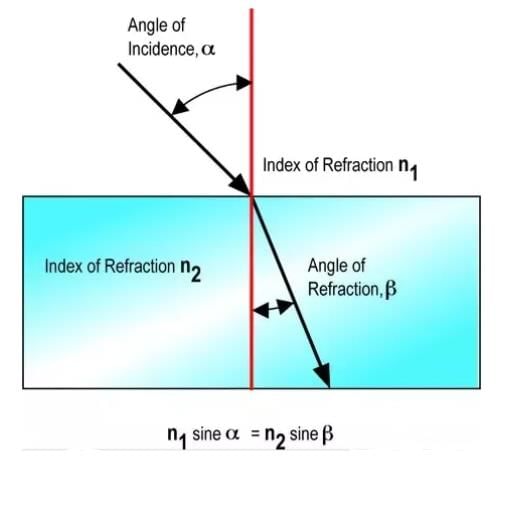
Sunlight enters the Earth's atmosphere from the vacuum of space. The refractive index of air with respect to vacuum is 1.0029. This means that the speed of light in air is 1.0029 times slower than the speed of light in vacuum. This causes the light rays to bend towards the normal (refraction).

The focal length of a convex lens (refractive index = 1.5) in air is 20 cm. When immersed in water (refractive index = 1.33), its focal length will be- a)20.2cm
- b)78.23 cm
- c)7.23 cm
- d)2.02 cm
Correct answer is option 'B'. Can you explain this answer?
The focal length of a convex lens (refractive index = 1.5) in air is 20 cm. When immersed in water (refractive index = 1.33), its focal length will be
a)
20.2cm
b)
78.23 cm
c)
7.23 cm
d)
2.02 cm
|
|
Nikita Singh answered |
Focal length in air = 20 cm
Refractive index of air-water n₁= 1.33
Refractive index of air - glass n₂= 1.5
For focal length in air,
Using formula of lens
1/fair={(n2/n1)-1}(1/R1)-(1/R2)
Put the value into the formula
1/20={(1.5/1)-1}{(1/R1)-(1/R2)}
1/20=0.5{(1/R1)-(1/R2)}…1
We need to calculate the focal length in water
Using formula of lens
1/fwater={(1.5/1.33)-1}{(1/R1)-(1/R2)}
1/fwater=0.128{(1/R1)-(1/R2)}….2
fwater/20=0.5/0.128
fwater=78.125cm
Refractive index of air-water n₁= 1.33
Refractive index of air - glass n₂= 1.5
For focal length in air,
Using formula of lens
1/fair={(n2/n1)-1}(1/R1)-(1/R2)
Put the value into the formula
1/20={(1.5/1)-1}{(1/R1)-(1/R2)}
1/20=0.5{(1/R1)-(1/R2)}…1
We need to calculate the focal length in water
Using formula of lens
1/fwater={(1.5/1.33)-1}{(1/R1)-(1/R2)}
1/fwater=0.128{(1/R1)-(1/R2)}….2
fwater/20=0.5/0.128
fwater=78.125cm
Due to _______ the depth of an optically denser medium appears to be _______ than its real depth.- a)Refraction , more
- b)Reflection , less
- c)Reflection , more
- d)Refraction , less
Correct answer is option 'D'. Can you explain this answer?
Due to _______ the depth of an optically denser medium appears to be _______ than its real depth.
a)
Refraction , more
b)
Reflection , less
c)
Reflection , more
d)
Refraction , less
|
|
Neha Sharma answered |
When light moves from 1 medium to another, refraction takes place. And when light enters a denser medium, the ray bends away from normal and meets at a point above the actual point where they would have met, if the medium was absent. So, apparent depth decreases.
A convex and a concave mirror of radii 10 cm each are facing each other and 15 cm apart. A point object is placed midway between them. Then position of the final image if the reflection first takes place at the concave mirror and then in the convex mirror is- a)at the pole of the concave mirror
- b)at the pole of the convex mirror
- c)5 cm behind the convex mirror
- d)coincident with the object itself
Correct answer is option 'B'. Can you explain this answer?
A convex and a concave mirror of radii 10 cm each are facing each other and 15 cm apart. A point object is placed midway between them. Then position of the final image if the reflection first takes place at the concave mirror and then in the convex mirror is
a)
at the pole of the concave mirror
b)
at the pole of the convex mirror
c)
5 cm behind the convex mirror
d)
coincident with the object itself

|
Aayush Agarwal answered |
It will be best understood if you make a scale diagram. I will advice you do so and simultaneously read the answer. at first the reflection takes place at concave mirror. the objeCt is at a distance of 7.5cm from it. and 2.5cm from its focus. thereby the image shall be made in front of the mirror. next the image made will act as an object for the convex Mirror. and then it will make the image at its pole. if you arent still able to understand, do let me know
Power of the lens is -40, its focal length is - a)4m
- b)-40m
- c)-0.25m
- d)-25m
Correct answer is option 'C'. Can you explain this answer?
Power of the lens is -40, its focal length is
a)
4m
b)
-40m
c)
-0.25m
d)
-25m
|
|
Jyoti Sengupta answered |
The power of a lens is the reciprocal of the focal length with measurement in metres. The unit is diopter.
It is given that the focal length of a convex lens is 10 cm = 0.1 m.
⇒ The power of the lens is 1/0.1= 10 diopter.
A thick plano convex lens made of crown glass (refractive index 1.5) has a thickness of 3cm at its centre. The radius of curvature of its curved face is 5cm. An ink mark made at the centre of its plane face, when viewed normally through the curved face, appears to be at a distance ‘x’ from the curved face. Then, x is equal to: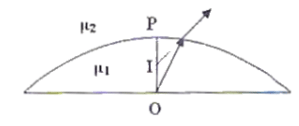
- a)2.5cm
- b)2.3cm
- c)2cm
- d)2.1cm
Correct answer is option 'A'. Can you explain this answer?
A thick plano convex lens made of crown glass (refractive index 1.5) has a thickness of 3cm at its centre. The radius of curvature of its curved face is 5cm. An ink mark made at the centre of its plane face, when viewed normally through the curved face, appears to be at a distance ‘x’ from the curved face. Then, x is equal to:
a)
2.5cm
b)
2.3cm
c)
2cm
d)
2.1cm
|
|
Shreya Gupta answered |
The ray of light from the object O (ink mark) gets refracted at the interface between lens and air and therefore appears to start from the point I (Fig). So, I is the refracted image of the object O. The object distance 'u' is PO and the image distance ‘v’ is PI. [P is the pole of the spherical surface].
We have, n2 /v – n1/u = (n2 – n1)/R so that 1/v – 1.5/(-3) = (1- 1.5)/(-5).
Note that we did not bother about the sign of the unknown quantity ‘v’. [In this problem we could have put negative sign for ‘v’ since the image I is on the same side as the object. Since we don’t apply sign to the unknown quantity ‘v’, we will obtain a negative value for ‘v’ on solving the problem]. The sign of ‘u’ is negative in accordance with the Cartesian convention. Since the incident ray is encountering a concave surface the radius of curvature is negative, in accordance with the convention.
Rearranging the above equation, we obtain 1/v = 0.5/5 – 1.5/3 = -6/15 from which v = -2.5cm.
Bending effect of light as it passes from one transparent material into other is known as- a)refraction
- b)deflection
- c)reflection
- d)diffraction
Correct answer is option 'A'. Can you explain this answer?
Bending effect of light as it passes from one transparent material into other is known as
a)
refraction
b)
deflection
c)
reflection
d)
diffraction
|
|
Leelu Bhai answered |
Its refraction yrr.. This is a common definition of refraction that u r asking 🤦🏻♂️
An air bubble inside a glass slab (μ = 1.5) appears at 6 cm when viewed from the opposite side. The thickness of the slab is:- a)10 cm
- b)6.67 cm
- c)15 cm
- d)None of the above
Correct answer is option 'C'. Can you explain this answer?
An air bubble inside a glass slab (μ = 1.5) appears at 6 cm when viewed from the opposite side. The thickness of the slab is:
a)
10 cm
b)
6.67 cm
c)
15 cm
d)
None of the above
|
|
Krishna Iyer answered |
We know that μ=(apparent depth/real depth)
Let the thickness of the slab be t and real depth of the bubble from one side be x. Then
μ=(x/6)=(t−x)/4 or 1.5=x/6 = (t−x)/4
This gives x=9 and 1.5=(t−9)/4 or t=15cm
______ mirror is called as diverging mirror- a)Concave
- b)Plane
- c)Convex
- d)Both b and c
Correct answer is option 'C'. Can you explain this answer?
______ mirror is called as diverging mirror
a)
Concave
b)
Plane
c)
Convex
d)
Both b and c
|
|
Preeti Iyer answered |
Concave mirror is called a converging mirror because parallel rays of light fall on the mirror they converge at a point called focus. Convex mirror is called a diverging mirror because parallel rays of light fall on it they diverge after reflection.
A ray of light going from denser to rarer medium suffers refraction at a concave surface. Which of the following relations is correct?- a)

- b)

- c)

- d)

Correct answer is option 'A'. Can you explain this answer?
A ray of light going from denser to rarer medium suffers refraction at a concave surface. Which of the following relations is correct?
a)
b)
c)
d)

|
EduRev JEE answered |
Solution :
The correct option is Option A.
Laws of refraction;-
The incident ray,the refracted ray and the normal to the refracting surface at the point of incidence lie in the same plane.
For a given pair of media and for a given colour of light the ration between the sine of angle of incidence to the sine of refraction is a constant.This constant is known as refractive index of the second medium with respect to the first medium.
When a ray of light passes through a glass slab, ∠i,∠r and the normal all lie in the same plane.
When a ray of light passes from one medium to another, here from air to glass or glass to air, the ratio sini / sinr = constant.
A microscope is focused on an ink mark on the top of a table. If we place a glass slab 3cm thick on it, how should the microscope be moved to focus the ink spot again? The refractive index of glass slab is 1.5 cm.- a)2 cm downward
- b)1 cm upwards
- c)1 cm downwards
- d)2 cm upwards
Correct answer is option 'B'. Can you explain this answer?
A microscope is focused on an ink mark on the top of a table. If we place a glass slab 3cm thick on it, how should the microscope be moved to focus the ink spot again? The refractive index of glass slab is 1.5 cm.
a)
2 cm downward
b)
1 cm upwards
c)
1 cm downwards
d)
2 cm upwards
|
|
Shreya Gupta answered |
The image of the ink spot moves up by 1cm.
Refractive index = Real depth/ apparent depth
1.5 = 3/ apparent depth
Apparent depth = 3/1.5 = 2 cm
Distance through which the microscope is moved is 3 cm -2 cm = 1 cm upwards
A ray of light passes through a plane glass slab of thickness t and refractive index μ = 1.5. The angle between the incident ray and emergent ray will be:- a)30°
- b)45°
- c)60°
- d)0°
Correct answer is option 'D'. Can you explain this answer?
A ray of light passes through a plane glass slab of thickness t and refractive index μ = 1.5. The angle between the incident ray and emergent ray will be:
a)
30°
b)
45°
c)
60°
d)
0°

|
Ayush Joshi answered |
The incident ray and emergent ray are parallel to each other but latteray displaced due to reflaction at two surfaces . So, the angle between them is Zero.
Can absolute value of refractive index be less than unity?- a)No
- b)Refractive index is always unity
- c)Depends on situation
- d)Yes
Correct answer is option 'A'. Can you explain this answer?
Can absolute value of refractive index be less than unity?
a)
No
b)
Refractive index is always unity
c)
Depends on situation
d)
Yes
|
|
Vijay Bansal answered |
Absolute refractive index of a medium = speed of light in vacuum / speed of light in in that medium.
Since the speed of light is maximum in vacuum, the refractive index cannot be less than unity.
A virtual image, larger than the object can be produced by- a)Convex mirror
- b)Concave mirror
- c)Plane mirror
- d)Concave lens
Correct answer is option 'B'. Can you explain this answer?
A virtual image, larger than the object can be produced by
a)
Convex mirror
b)
Concave mirror
c)
Plane mirror
d)
Concave lens
|
|
Ayaan Madhukar answered |
CONCAVE MIRROR...
Concave mirrors produce real and virtual, erect and inverted, diminished same size and magnified image depending upon the position of the object on the principal axis.
But the concave mirror forms a virtual and enlarged image when the object is placed between the focus and the pole of the mirror...
$$Hope it's help...$$
Concave mirrors produce real and virtual, erect and inverted, diminished same size and magnified image depending upon the position of the object on the principal axis.
But the concave mirror forms a virtual and enlarged image when the object is placed between the focus and the pole of the mirror...
$$Hope it's help...$$
In a concave mirror when the object is located beyond C the magnification is- a)More than 1
- b)Equal to 1
- c)Less than 1
- d)Both a and b
Correct answer is option 'C'. Can you explain this answer?
In a concave mirror when the object is located beyond C the magnification is
a)
More than 1
b)
Equal to 1
c)
Less than 1
d)
Both a and b
|
|
Rajeev Saxena answered |
In the animation above, a right-side-up object is located above the principal axis at a position beyond the center of curvature (C). The ray diagram shows that the image of this object is located as an upside-down image positioned between the center of curvature (C) and the focal point (F). In fact, it can be generalized that anytime the object is located beyond the center of curvature, the image will be located somewhere between the center of curvature and the focal point. In such cases, the image will be inverted and reduced in size (i.e., smaller than the object). Such images are called real images because they are formed by the actual convergence of reflected light rays at the image location. Real images are always formed on the same side of the mirror as the object.
When light is reflected from a mirror a change occurs in its- a)phase,
- b)frequency,
- c)wavelength,
- d)speed
Correct answer is option 'A'. Can you explain this answer?
When light is reflected from a mirror a change occurs in its
a)
phase,
b)
frequency,
c)
wavelength,
d)
speed

|
Ramesh Chand answered |
When a light wave is reflected from an object , it changes not only it's amplitude but also its phase according to the properties of the object at a particular point. Therefore, option A is the right answer.
In image formation from spherical mirrors, only paraxial rays are considered because they- a)are easy to handle geometrically
- b)contain most of the intensity of the incident light
- c)form nearly a point image of a point source
- d)show minimum dispersion effect.
Correct answer is option 'C'. Can you explain this answer?
In image formation from spherical mirrors, only paraxial rays are considered because they
a)
are easy to handle geometrically
b)
contain most of the intensity of the incident light
c)
form nearly a point image of a point source
d)
show minimum dispersion effect.
|
|
Riya Banerjee answered |
Paraxial rays are ones which originate from a point source and make a small angle with the principal axis. After reflection, they give a point image, either real or virtual.
But if rays from point source that are far from the mirror axis, gives a blurred image, an effect called spherical aberration.
But if rays from point source that are far from the mirror axis, gives a blurred image, an effect called spherical aberration.
Two mirrors are placed perpendicular to each other. A ray strikes the first mirror and after reflection from the first mirror it falls on the second mirror. The ray after reflection from second mirror will emerge- a)Perpendicular to the original ray
- b)Parallel to the original ray
- c)At 450 to the original ray
- d)At 600 to the original ray
Correct answer is option 'B'. Can you explain this answer?
Two mirrors are placed perpendicular to each other. A ray strikes the first mirror and after reflection from the first mirror it falls on the second mirror. The ray after reflection from second mirror will emerge
a)
Perpendicular to the original ray
b)
Parallel to the original ray
c)
At 450 to the original ray
d)
At 600 to the original ray
|
|
Preeti Iyer answered |
Let ray strikes the vertical mirror by angle of incidence θ. Then by joining the perpendiculars of two mirrors it is clear from the diagram that angle of incidence at the horizontal mirror is (90−θ).
∴ reflected ray from the horizontal mirror makes angle θ with the horizontal mirror also incident ray at vertical mirror makes angle θ with horizontal axis.
∴ reflected ray is parallel to the original ray.
This is true for two perpendicular mirrors fixed at any positions.
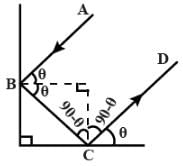
∴ reflected ray from the horizontal mirror makes angle θ with the horizontal mirror also incident ray at vertical mirror makes angle θ with horizontal axis.
∴ reflected ray is parallel to the original ray.
This is true for two perpendicular mirrors fixed at any positions.

If an object is placed unsymmetrically between two plane mirrors, inclined at the angle of 600, then the total number of images formed is- a)5
- b)4
- c)2
- d)infinite
Correct answer is option 'A'. Can you explain this answer?
If an object is placed unsymmetrically between two plane mirrors, inclined at the angle of 600, then the total number of images formed is
a)
5
b)
4
c)
2
d)
infinite
|
|
Hansa Sharma answered |
The number of images between two plane mirror inclined at an angle θ when the object is placed symmetrically between the mirrors is given as
n=(360o/ θ) −1
Given,
θ=60o
∴n=(360o/60)−1=6−1=5
n=(360o/ θ) −1
Given,
θ=60o
∴n=(360o/60)−1=6−1=5
Which of the following letters do not surface lateral inversion- a)HGA
- b)HOX
- c)VET
- d)YUL
Correct answer is option 'B'. Can you explain this answer?
Which of the following letters do not surface lateral inversion
a)
HGA
b)
HOX
c)
VET
d)
YUL
|
|
Hansa Sharma answered |
Lateral inversion-The phenomenon of left side appearing right side and right side appearing left side on reflection in a plane mirror is called lateral inversion.
Letters that do not show lateral inversion are,
A, H, I, M, O, T, U, V, W, X, Y
Hence, HOX will not show lateral inversion.
Letters that do not show lateral inversion are,
A, H, I, M, O, T, U, V, W, X, Y
Hence, HOX will not show lateral inversion.
Newtonian reflecting type telescope uses- a)Concave mirror
- b)Convex lens
- c)Concave lens
- d)Convex mirror
Correct answer is option 'B'. Can you explain this answer?
Newtonian reflecting type telescope uses
a)
Concave mirror
b)
Convex lens
c)
Concave lens
d)
Convex mirror
|
|
Ishan Choudhury answered |
A reflecting telescope (also called a reflector) is a telescope that uses a single or a combination of curved mirrors that reflect light and form an image. The reflecting telescope was invented in the 17th century, by Isaac Newton, as an alternative to the refracting telescope which, at that time, was a design that suffered from severe chromatic aberration. Although reflecting telescopes produce other types of optical aberrations, it is a design that allows for very large diameter objectives.
Astronomical (reflecting) telescopes. In a reflecting telescope, instead of a convex objective lens, a concave mirror is used to collect parallel rays from the object and form an image at the focal point. Then the convex eyepiece lens is used to magnify this image for the viewer.
An image is upright and reduced in size. Which mirror is used to form such an image?- a)Convex
- b)Concave
- c)Plane
- d)Both a and c
Correct answer is option 'D'. Can you explain this answer?
An image is upright and reduced in size. Which mirror is used to form such an image?
a)
Convex
b)
Concave
c)
Plane
d)
Both a and c
|
|
Nikita Singh answered |
Only Convex Mirror can form an image which is upright and reduced in size.
Mark the correct options- a)If the incident rays are converging, we have a real object.
- b)If the final rays are converging, we have a real image.
- c)The image of a virtual object is called a virtual image.
- d)If the image is virtual, the corresponding object is called a virtual object
Correct answer is option 'B'. Can you explain this answer?
Mark the correct options
a)
If the incident rays are converging, we have a real object.
b)
If the final rays are converging, we have a real image.
c)
The image of a virtual object is called a virtual image.
d)
If the image is virtual, the corresponding object is called a virtual object
|
|
Geetika Shah answered |
If the final rays are converging, we have a real image.
This is because a real image is formed by converging reflected/refracted rays from a mirror/lens.
The correct answer is option B.
This is because a real image is formed by converging reflected/refracted rays from a mirror/lens.
The correct answer is option B.
The focal length of spherical mirror is- a)Maximum for red light
- b)Maximum for blue light
- c)Maximum for white light
- d)Same for all lights
Correct answer is option 'D'. Can you explain this answer?
The focal length of spherical mirror is
a)
Maximum for red light
b)
Maximum for blue light
c)
Maximum for white light
d)
Same for all lights
|
|
Lavanya Menon answered |
Focal length is the property of a spherical mirror. It does not depend on the light used. So, it is the same for all lights.
A convex mirror has a focal length f. A real object, placed at a distance f in front of it from the pole, produces an image at- a)2 f
- b)f/2
- c)f
- d)¥
Correct answer is option 'B'. Can you explain this answer?
A convex mirror has a focal length f. A real object, placed at a distance f in front of it from the pole, produces an image at
a)
2 f
b)
f/2
c)
f
d)
¥
|
|
Preeti Iyer answered |
Here F=f
U=-f(-because it is present in front of a convex lens)
It is given that both focal length and object distance is f .
So according to lens formula 1/F=1/v+1/u
So 1/f=(1/v)+(-1/f)
=>1/f=(1/v)-(1/f)
So (1/f)+(1/f)=1/f
=>1+(1/f)=(1/v)
=>2/f=1/v
So from here we can say that v= f/2
Hence option B is correct.
U=-f(-because it is present in front of a convex lens)
It is given that both focal length and object distance is f .
So according to lens formula 1/F=1/v+1/u
So 1/f=(1/v)+(-1/f)
=>1/f=(1/v)-(1/f)
So (1/f)+(1/f)=1/f
=>1+(1/f)=(1/v)
=>2/f=1/v
So from here we can say that v= f/2
Hence option B is correct.
An object is initially at a distance of 100 cm from a plane mirror. If the mirror approaches the object at a speed of 5 cm/s. Then after 6 s the distance between the object and its image will be- a)60 cm
- b)140 cm
- c)170 cm
- d)150 cm
Correct answer is option 'B'. Can you explain this answer?
An object is initially at a distance of 100 cm from a plane mirror. If the mirror approaches the object at a speed of 5 cm/s. Then after 6 s the distance between the object and its image will be
a)
60 cm
b)
140 cm
c)
170 cm
d)
150 cm
|
|
Lavanya Menon answered |
Given that,
The distance of object from plane mirror D=100cm
So, initial distance of image and object
=100−(−100)
=200cm
Now, object approaches the mirror with the speed=v=5cm/s
So, distance travelled by object in 6 sec
D=5×6
D=30cm
At this instant,
Distance between mirror and object
D=100−30
D=70cm
Now, the distance between image and object is
D=70−(−70)
D=140cm
Hence, the distance between the object and its image is 140 cm.
The distance of object from plane mirror D=100cm
So, initial distance of image and object
=100−(−100)
=200cm
Now, object approaches the mirror with the speed=v=5cm/s
So, distance travelled by object in 6 sec
D=5×6
D=30cm
At this instant,
Distance between mirror and object
D=100−30
D=70cm
Now, the distance between image and object is
D=70−(−70)
D=140cm
Hence, the distance between the object and its image is 140 cm.
The radius of curvature for a convex lens is 40 cm, for each surface. Its refractive index is 1.5. The focal length will be - a)40 cm
- b)20 cm
- c)80 cm
- d)30 cm
Correct answer is option 'A'. Can you explain this answer?
The radius of curvature for a convex lens is 40 cm, for each surface. Its refractive index is 1.5. The focal length will be
a)
40 cm
b)
20 cm
c)
80 cm
d)
30 cm
|
|
Hansa Sharma answered |
Let the radius of curvature of the convex lens are denoted as
For a convex lens
R1=+40cm [As it is towards right]
R2=-40cm [As it is towards left]
The refractive index of the lens [µ]=1.5
Let f is the focal length of the lens.
From lens maker's formula we know that –
1/f=[µ-1] [1/R1-1/R2]
1/f=[1.5-1][1/40-(1/-40)]
1/f=0.5 x (2/40)
1/f=1/40
f=40cm
Hence, the focal length of the lens is 40 cm.
For a convex lens
R1=+40cm [As it is towards right]
R2=-40cm [As it is towards left]
The refractive index of the lens [µ]=1.5
Let f is the focal length of the lens.
From lens maker's formula we know that –
1/f=[µ-1] [1/R1-1/R2]
1/f=[1.5-1][1/40-(1/-40)]
1/f=0.5 x (2/40)
1/f=1/40
f=40cm
Hence, the focal length of the lens is 40 cm.
An object is placed at a distance u from a concave mirror and its real image is received on a screen placed at a distance of v from the mirror. If f is the focal length of the mirror, then the graph between 1/v versus 1/u is- a)
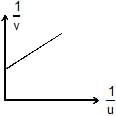
- b)
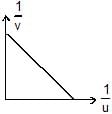
- c)

- d)
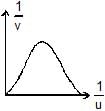
Correct answer is option 'B'. Can you explain this answer?
An object is placed at a distance u from a concave mirror and its real image is received on a screen placed at a distance of v from the mirror. If f is the focal length of the mirror, then the graph between 1/v versus 1/u is
a)
b)
c)
d)

|
Divey Sethi answered |
For real object and real Image,
(1/v)+(1/u)=(1/f)=> -(1/v)-(1/u)=-(1/f)
(1/v)+(1/u)=(1/f) => 1/v=-(1/u)+(1/f)
y=mx+c
The correct answer is option B.
(1/v)+(1/u)=(1/f)=> -(1/v)-(1/u)=-(1/f)
(1/v)+(1/u)=(1/f) => 1/v=-(1/u)+(1/f)
y=mx+c
The correct answer is option B.
What is the Principle of Reversibility?- a)If the final path of a ray of light is reversed after any number of reflections and refractions, then the ray retraces its entire path.
- b)If the final path of a ray of light is reversed after any number of refractions only, then the ray retraces its entire path.
- c)If the final path of a ray of light is reversed after any number of reflections and refractions, then the ray retraces half of its path.
- d)If the initial path of a ray of light is reversed after any number of reflections only, then the ray retraces its entire path.
Correct answer is option 'A'. Can you explain this answer?
What is the Principle of Reversibility?
a)
If the final path of a ray of light is reversed after any number of reflections and refractions, then the ray retraces its entire path.
b)
If the final path of a ray of light is reversed after any number of refractions only, then the ray retraces its entire path.
c)
If the final path of a ray of light is reversed after any number of reflections and refractions, then the ray retraces half of its path.
d)
If the initial path of a ray of light is reversed after any number of reflections only, then the ray retraces its entire path.
|
|
Preeti Iyer answered |
The principle of reversibility of light :-
If the path of light is reversed after a number for reflections and refraction then it retraces it's path.

Note the directions of the arrow.
The beam of light travels back on the same path as it was traveling before the refraction and after the refraction after being encountered by the obstacle in the water.
A concave mirror gives an image three times as large as the object placed at a distance of 20 cm from it. For the image to be real, the focal length should be- a)10 cm
- b)15 cm
- c)20 cm
- d)30 cm
Correct answer is option 'B'. Can you explain this answer?
A concave mirror gives an image three times as large as the object placed at a distance of 20 cm from it. For the image to be real, the focal length should be
a)
10 cm
b)
15 cm
c)
20 cm
d)
30 cm
|
|
Hansa Sharma answered |
Given, u=−20cm
m=−3⇒−v/u =−3
v=−60cm
1/f=(1/v)+(1/u)=(-1/60)−(1/20)=−1−3/60
f=−60/4=−15cm
m=−3⇒−v/u =−3
v=−60cm
1/f=(1/v)+(1/u)=(-1/60)−(1/20)=−1−3/60
f=−60/4=−15cm
A concave mirror cannot form- a)virtual image of virtual object
- b)virtual image of a real object
- c)real image of a real object
- d)real image of a virutal object
Correct answer is option 'A'. Can you explain this answer?
A concave mirror cannot form
a)
virtual image of virtual object
b)
virtual image of a real object
c)
real image of a real object
d)
real image of a virutal object
|
|
Ritu Singh answered |
-Virtual image cannot be formed from a virtual object.
- When an object is placed between pole and focus, the image formed by the concave mirror is magnified, virtual and erect.
-When an object is placed beyond the centre of curvature , the image of it is formed between the centre of curvature and focus which is diminished,real and inverted,so the real image of the real object can be formed by a concave mirror.
-When the object is virtual, the image formed is real for the concave surface as shown in figure.
- When an object is placed between pole and focus, the image formed by the concave mirror is magnified, virtual and erect.
-When an object is placed beyond the centre of curvature , the image of it is formed between the centre of curvature and focus which is diminished,real and inverted,so the real image of the real object can be formed by a concave mirror.
-When the object is virtual, the image formed is real for the concave surface as shown in figure.
Consider a curved surface between two different media with refractive indices n1 = 1 and n2 = 2. The relation between radius of curvature, image distance and object distance is given by- a)

- b)

- c)

- d)

Correct answer is option 'D'. Can you explain this answer?
Consider a curved surface between two different media with refractive indices n1 = 1 and n2 = 2. The relation between radius of curvature, image distance and object distance is given by
a)
b)
c)
d)
|
|
Gaurav Kumar answered |
The relation between radius of curvature, image distance and object distance is given by
n2/v-n1/u=n2-n1
un2-vn2/vu=n2-n1/R
R=vu(n2-n2)/un2-vn2
=uv(2)/u(2)-v(1)
=[uv/2u-v)
n2/v-n1/u=n2-n1
un2-vn2/vu=n2-n1/R
R=vu(n2-n2)/un2-vn2
=uv(2)/u(2)-v(1)
=[uv/2u-v)
If an object is 30 cm away from a concave mirror of focal length 15 cm, the image will be- a)erect
- b)virtual
- c)diminished
- d)of same size
Correct answer is option 'D'. Can you explain this answer?
If an object is 30 cm away from a concave mirror of focal length 15 cm, the image will be
a)
erect
b)
virtual
c)
diminished
d)
of same size
|
|
Nandita Ahuja answered |
Explanation:
When an object is placed at a distance of 2f (twice the focal length) from a concave mirror, the image formed is of the same size as the object.
In this case, the object is placed at a distance of 30 cm from a concave mirror of focal length 15 cm. So, the distance between the object and the mirror is:
u = -30 cm (since the object is placed in front of the mirror)
f = -15 cm (since the mirror is concave)
Using the mirror formula:
1/f = 1/v + 1/u
1/-15 = 1/v + 1/-30
-2/30 = 1/v
v = -15 cm
So, the image is formed at a distance of 15 cm from the mirror. The magnification is given by:
m = -v/u
m = -15/-30
m = 1/2
Since the magnification is positive, the image formed is erect. And since the magnification is less than 1, the image formed is diminished.
However, since the object is placed at a distance of 2f from the mirror, the image formed is of the same size as the object. Therefore, option D is the correct answer.
When an object is placed at a distance of 2f (twice the focal length) from a concave mirror, the image formed is of the same size as the object.
In this case, the object is placed at a distance of 30 cm from a concave mirror of focal length 15 cm. So, the distance between the object and the mirror is:
u = -30 cm (since the object is placed in front of the mirror)
f = -15 cm (since the mirror is concave)
Using the mirror formula:
1/f = 1/v + 1/u
1/-15 = 1/v + 1/-30
-2/30 = 1/v
v = -15 cm
So, the image is formed at a distance of 15 cm from the mirror. The magnification is given by:
m = -v/u
m = -15/-30
m = 1/2
Since the magnification is positive, the image formed is erect. And since the magnification is less than 1, the image formed is diminished.
However, since the object is placed at a distance of 2f from the mirror, the image formed is of the same size as the object. Therefore, option D is the correct answer.
A person is in a room whose ceiling and two adjacent walls are mirrors. How many images are formed ?- a)5
- b)6
- c)7
- d)8
Correct answer is option 'C'. Can you explain this answer?
A person is in a room whose ceiling and two adjacent walls are mirrors. How many images are formed ?
a)
5
b)
6
c)
7
d)
8
|
|
Geetika Shah answered |
The number of images formed when two mirrors are inclined to each other is given by :
n=(360/θ -1)
here θ= 90°[since walls are perpendicular]
so, number of images=n=360/90-1
=4-1
=3
These 3 images are formed by a combination of two adjacent walls with the object itself acts as objects for the ceiling mirror. So totally 4 images are formed.
Hence total number of images formed are 4+3= 7
n=(360/θ -1)
here θ= 90°[since walls are perpendicular]
so, number of images=n=360/90-1
=4-1
=3
These 3 images are formed by a combination of two adjacent walls with the object itself acts as objects for the ceiling mirror. So totally 4 images are formed.
Hence total number of images formed are 4+3= 7
In the adjoining figure, SS is a spherical surface separating two media of refractive indices n1 and n2 where n1 > n2. C is the centre of curvature of the spherical surface. An observer, keeping his eye beyond C in the medium of refractive index n2 views the refracted image of an object AB placed as shown in the medium of refractive index n1. The image will be:
- a)real, upright and diminished
- b)virtual, upright and magnified
- c)real, inverted and magnified
- d)virtual, upright and diminished
Correct answer is option 'D'. Can you explain this answer?
In the adjoining figure, SS is a spherical surface separating two media of refractive indices n1 and n2 where n1 > n2. C is the centre of curvature of the spherical surface. An observer, keeping his eye beyond C in the medium of refractive index n2 views the refracted image of an object AB placed as shown in the medium of refractive index n1. The image will be:
a)
real, upright and diminished
b)
virtual, upright and magnified
c)
real, inverted and magnified
d)
virtual, upright and diminished

|
Mohit Rajpoot answered |

The image will be virtual, upright and diminished.
A rays is incident at an angle 38º on a mirror. The angle between normal and reflected ray is- a)38º
- b)52º
- c)90º
- d)76º
Correct answer is option 'A'. Can you explain this answer?
A rays is incident at an angle 38º on a mirror. The angle between normal and reflected ray is
a)
38º
b)
52º
c)
90º
d)
76º
|
|
Kalyan Joshi answered |
As per the question, rays are falling on the mirror, which cleared that Regular reflection is taking place.
So, As per the laws of regular reflection.
=> ∠incident= ∠reflection
∠incident= ∠reflection=38Ao
Also we know that normal is at 90°to the mirror.
Now, to get the required angle we need to reduce angle of reflection from normal.
=>90Ao-38Ao=52Ao
so, the correct answer is option B.
So, As per the laws of regular reflection.
=> ∠incident= ∠reflection
∠incident= ∠reflection=38Ao
Also we know that normal is at 90°to the mirror.
Now, to get the required angle we need to reduce angle of reflection from normal.
=>90Ao-38Ao=52Ao
so, the correct answer is option B.
A point object is kept in front of a plane mirror. The plane mirror is doing SHM of amplitude 2cm. The plane mirror moves along the x-axis and x-axis is normal to the mirror. The amplitude of the mirror is such that the object is always infront of the mirror. The amplitude of SHM of the image is- a)zero
- b)2 cm
- c)4 cm
- d)1 cm
Correct answer is option 'C'. Can you explain this answer?
A point object is kept in front of a plane mirror. The plane mirror is doing SHM of amplitude 2cm. The plane mirror moves along the x-axis and x-axis is normal to the mirror. The amplitude of the mirror is such that the object is always infront of the mirror. The amplitude of SHM of the image is
a)
zero
b)
2 cm
c)
4 cm
d)
1 cm
|
|
Jayant Mishra answered |
The answer is 4cm.
In reflection on a plane mirror the image distance is equal to the object distance.
The size of the image equals to the size of the object.
Therefore the size of the amplitude of the reflected amplitude equals the size of the original amplitude.
A particle is moving towards a fixed spherical mirror. The image :- a)Must move away from the mirror
- b)Must move towards the mirror.
- c)May move towards the mirror.
- d)Will move towards the mirror, only if the mirror is convex.
Correct answer is option 'D'. Can you explain this answer?
A particle is moving towards a fixed spherical mirror. The image :
a)
Must move away from the mirror
b)
Must move towards the mirror.
c)
May move towards the mirror.
d)
Will move towards the mirror, only if the mirror is convex.
|
|
Rajat Kapoor answered |
If the mirror is concave and a real object is approaching it, the image will move away from the mirror for object distance greater than focal length. If object distance is less than the focal length, virtual image will be formed which moves towards the mirror. If mirror is convex, as object is approaching the mirror, image will move from focus to pole ie, towards the mirror.
The images of clouds and trees in water always less bright than in reality- a)because water is forming the image dirty
- b)because there is an optical illusion due to which the image appears to be less bright
- c)because only a portion of the incident light is reflected and quite a large portion goes mid water
- d)because air above the surface of water contains a lot of moisture
Correct answer is option 'C'. Can you explain this answer?
The images of clouds and trees in water always less bright than in reality
a)
because water is forming the image dirty
b)
because there is an optical illusion due to which the image appears to be less bright
c)
because only a portion of the incident light is reflected and quite a large portion goes mid water
d)
because air above the surface of water contains a lot of moisture
|
|
Rishika Patel answered |
The images of clouds and trees in water are always less bright than in reality because only a portion of the incident light is reflected and quite a large portion goes mid water.
If a ray of light is incident on a plane mirror at an angle 60° from the mirror surface, then deviation produced by mirror is- a)30°
- b)60°
- c)90°
- d)120°
Correct answer is option 'D'. Can you explain this answer?
If a ray of light is incident on a plane mirror at an angle 60° from the mirror surface, then deviation produced by mirror is
a)
30°
b)
60°
c)
90°
d)
120°
|
|
Anisha Bose answered |
The angle of incidence is the angle between the incident ray and the normal to the mirror at the point of incidence. In this case, the angle of incidence is 60 degrees.
The angle of reflection is the angle between the reflected ray and the normal to the mirror at the point of incidence. According to the law of reflection, this angle is equal to the angle of incidence. Therefore, the angle of reflection in this case is also 60 degrees.
The normal to the mirror is a line perpendicular to the surface of the mirror at the point of incidence. If the incident ray is coming from the left side of the mirror and making an angle of 60 degrees with the normal, then the reflected ray will be on the right side of the mirror and also make an angle of 60 degrees with the normal.
The incident ray, the reflected ray, and the normal all lie in the same plane, which is the plane of the mirror. This is also true for any other incident ray that makes an angle of 60 degrees with the normal at the point of incidence.
The image of an object formed by a plane mirror is virtual, upright, and the same size as the object. The image is located behind the mirror and is at the same distance from the mirror as the object is in front of the mirror. In this case, the image will be located at a distance of 2 times the distance of the object from the mirror.
The angle of reflection is the angle between the reflected ray and the normal to the mirror at the point of incidence. According to the law of reflection, this angle is equal to the angle of incidence. Therefore, the angle of reflection in this case is also 60 degrees.
The normal to the mirror is a line perpendicular to the surface of the mirror at the point of incidence. If the incident ray is coming from the left side of the mirror and making an angle of 60 degrees with the normal, then the reflected ray will be on the right side of the mirror and also make an angle of 60 degrees with the normal.
The incident ray, the reflected ray, and the normal all lie in the same plane, which is the plane of the mirror. This is also true for any other incident ray that makes an angle of 60 degrees with the normal at the point of incidence.
The image of an object formed by a plane mirror is virtual, upright, and the same size as the object. The image is located behind the mirror and is at the same distance from the mirror as the object is in front of the mirror. In this case, the image will be located at a distance of 2 times the distance of the object from the mirror.
A straight line joining the object point and image point is always perpendicular to the mirror- a) If mirror is plane only
- b) If mirror is concave only
- c)If mirror is convex only
- d)None of these
Correct answer is option 'D'. Can you explain this answer?
A straight line joining the object point and image point is always perpendicular to the mirror
a)
If mirror is plane only
b)
If mirror is concave only
c)
If mirror is convex only
d)
None of these
|
|
Shreya Gupta answered |
A straight line joining the object point and image point is always perpendicular to the mirror because it passes through the centre of curvature in spherical mirrors. And in case of plane mirrors they bisects the line between the object and the image.
A concave mirror of radius of curvature 20 cm forms image of the sun. The diameter of the sun subtends an angle 1° on the earth. Then the diameter of the image is (in cm)- a)2π/9
- b)π/9
- c)20
- d)π/18
Correct answer is option 'D'. Can you explain this answer?
A concave mirror of radius of curvature 20 cm forms image of the sun. The diameter of the sun subtends an angle 1° on the earth. Then the diameter of the image is (in cm)
a)
2π/9
b)
π/9
c)
20
d)
π/18
|
|
Madhurima Mishra answered |
Given: A concave mirror of radius of curvature 20cm forms image of the sun. The diameter of the sun subtends an angle 1o on the earth.
To find the diameter of the image
Solution:
As sun is more far from the earth,
Then we take u = infinite
Radius of curvature, R=−20cm
Focal length,

From the mirror formula
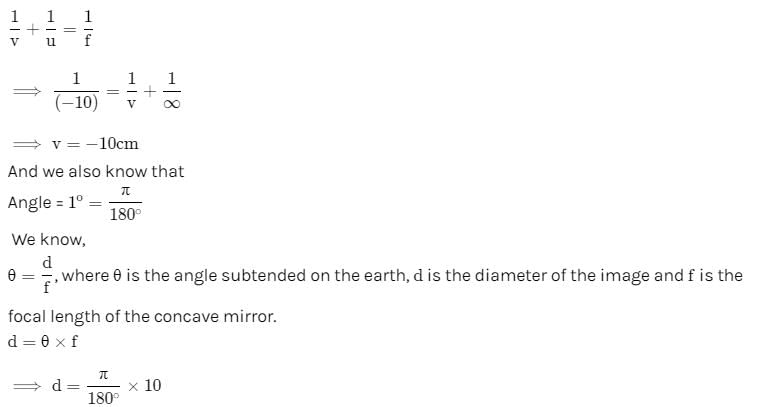
d = π/18
A point source of light is placed in front of a plane mirror.- a)Only the reflected rays close to the normal meet at a point when produced backward
- b)All the reflected rays meet at a point when produced backward
- c)Only the reflected rays making a small angle with the mirror, meet at a point when produced backward
- d)Light of different colours make different images
Correct answer is option 'B'. Can you explain this answer?
A point source of light is placed in front of a plane mirror.
a)
Only the reflected rays close to the normal meet at a point when produced backward
b)
All the reflected rays meet at a point when produced backward
c)
Only the reflected rays making a small angle with the mirror, meet at a point when produced backward
d)
Light of different colours make different images
|
|
Nisha Pillai answered |
Plane mirror always forms a virtual image of the real object for all the rays emitted by the object. So, when a point source of light is placed in front of a plane mirror, all the reflected rays meet at a point when produced backward.
Option B is correct.
Option B is correct.
In case of concave mirror, the minimum distance between a real object and its real image is :- a)f
- b)2f
- c)4f
- d)Zero
Correct answer is option 'D'. Can you explain this answer?
In case of concave mirror, the minimum distance between a real object and its real image is :
a)
f
b)
2f
c)
4f
d)
Zero
|
|
Shreya Gupta answered |
The minimum distance between an object and its real image in the case of a concave mirror is Zero.
When the object is at the 2F distance i.e. the center of curvature, then the image is real and formed inverted at the same distance.
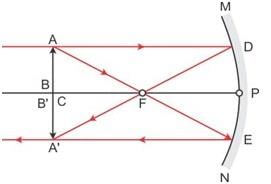

An infinitely long rod lies along the axis of a concave mirror of focal length f. The near end of the rod is at a distance u > f from the mirror. Its image will have a length- a)f2/(u _ f)
- b)uf/(u _ f)
- c)f2/(u + f)
- d)uf /(u + f)
Correct answer is option 'A'. Can you explain this answer?
An infinitely long rod lies along the axis of a concave mirror of focal length f. The near end of the rod is at a distance u > f from the mirror. Its image will have a length
a)
f2/(u _ f)
b)
uf/(u _ f)
c)
f2/(u + f)
d)
uf /(u + f)
|
|
Jyoti Kapoor answered |
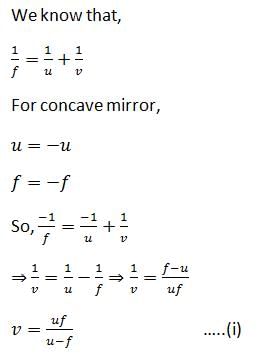
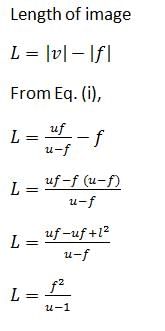
Just before setting, the sun may appear to be elliptical. This happens due to:- a)Refraction
- b)Dispersion
- c)Reflection
- d)Diffraction
Correct answer is option 'A'. Can you explain this answer?
Just before setting, the sun may appear to be elliptical. This happens due to:
a)
Refraction
b)
Dispersion
c)
Reflection
d)
Diffraction
|
|
Preeti Iyer answered |
Refraction, in physics, the change in direction of a wave passing from one medium to another caused by its change in speed. For example, waves in deep water travel faster than in shallow. If an ocean wave approaches a beach obliquely, the part of the wave farther from the beach will move faster than that closer in, and so the wave will swing around until it moves in a direction perpendicular to the shoreline. The speed of sound waves is greater in warm air than in cold. At night, air is cooled at the surface of a lake, and any sound that travels upward is refracted down by the higher layers of air that still remain warm. Thus, sounds, such as voices and music, can be heard much farther across water at night than in the daytime.
The largest distance of the image of a real object from a convex mirror of focal length 20 cm can be- a)20 cm
- b)infinite
- c)10 cm
- d)depends on the position of the object
Correct answer is option 'C'. Can you explain this answer?
The largest distance of the image of a real object from a convex mirror of focal length 20 cm can be
a)
20 cm
b)
infinite
c)
10 cm
d)
depends on the position of the object
|
|
Rutuja Ahuja answered |
We are given that:
Focal length = 20 cm
In a convex mirror image is formed between focal length and mirror.
So the maximum distance is f i.e. focal length of the mirror.
Now
f = 20 / 2 = 10 cm
Thus the largest distance of an image from a convex mirror is 10 cm.
Focal length = 20 cm
In a convex mirror image is formed between focal length and mirror.
So the maximum distance is f i.e. focal length of the mirror.
Now
f = 20 / 2 = 10 cm
Thus the largest distance of an image from a convex mirror is 10 cm.
Chapter doubts & questions for Ray Optics and Optical Instruments - 4 Months Preparation for NEET 2025 is part of NEET exam preparation. The chapters have been prepared according to the NEET exam syllabus. The Chapter doubts & questions, notes, tests & MCQs are made for NEET 2025 Exam. Find important definitions, questions, notes, meanings, examples, exercises, MCQs and online tests here.
Chapter doubts & questions of Ray Optics and Optical Instruments - 4 Months Preparation for NEET in English & Hindi are available as part of NEET exam.
Download more important topics, notes, lectures and mock test series for NEET Exam by signing up for free.

Contact Support
Our team is online on weekdays between 10 AM - 7 PM
Typical reply within 3 hours
|
Free Exam Preparation
at your Fingertips!
Access Free Study Material - Test Series, Structured Courses, Free Videos & Study Notes and Prepare for Your Exam With Ease

 Join the 10M+ students on EduRev
Join the 10M+ students on EduRev
|

|
Create your account for free
OR
Forgot Password
OR
Signup to see your scores
go up within 7 days!
Access 1000+ FREE Docs, Videos and Tests
Takes less than 10 seconds to signup









